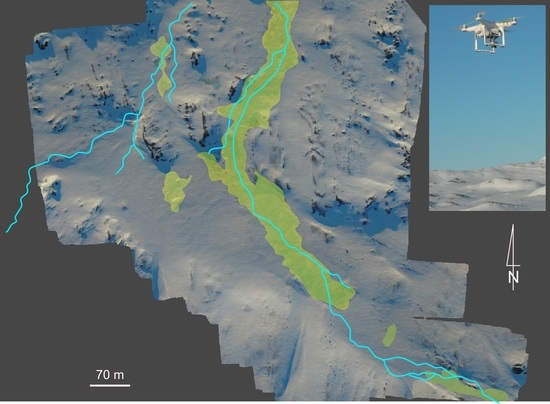Snowcover Survey over an Arctic Glacier Forefield: Contribution of Photogrammetry to Identify “Icing” Variability and Processes
Abstract
1. Introduction
- to derive Digital Surface Models (DSM) at maximum/minimum snow accumulation in order to quantify the snow water equivalent (SWE); and,
- to analyze icing dynamics over Austre Lovén proglacial moraine by focusing on highly responsive areas, such as river channels (Figure 1).
2. Study Site and Morphological Characteristics
3. Material and Methods
3.1. Reference Data
3.2. Image Acquisition Protocol
- in autumn, dedicated GCPs were deployed in the moraine along the flight paths, and their position was recorded prior to the UAV flights. According to post processing, the accuracy obtained reached values of 15 cm for 98% of the markers, in the three directions (X, Y, Z);
- large boulders were identified on the Norsk Polar Institutt orthophoto used as reference and, thanks to the ArcticDEM, the three coordinates of these reference points are identified and used as GCPs in addition to positioning on the field using the dual-frequency GPS receiver.
3.3. Manual Snow Measurement
3.4. Data Processing
4. Results and Discussion
4.1. Morphological Evidence of Icings Spatial Dynamics
4.2. Data Quality Assessment: Snow Depth Calculation
- the snowpack is in the range of a decimeter-to-meter deep and, hence, is easier to estimate by using photogrammetry; and,
- during the data processing step, cornices create shadows and structures that are identifiable by processing algorithm.
4.3. Water Equivalent Calculation
4.4. Lessons Learnt and Outlook
5. Conclusions
Author Contributions
Funding
Conflicts of Interest
References
- Nuth, C.; Moholdt, G.; Kohler, J.; Hagen, J.O.; Kääb, A. Svalbard glacier elevation changes and contribution to sea level rise. J. Geophys. Res. 2010, 115, F01008. [Google Scholar] [CrossRef]
- Hock, R. Glacier melt: A review of processes and their modelling. Prog. Phys. Geogr. 2005, 29, 362–391. [Google Scholar] [CrossRef]
- Lehning, M.; Ingo, V.; Gustafsson, D.; Nguyen, T.A.; St, M.; Zappa, M. ALPINE3D: A detailed model of mountain surface processes and its application to snow hydrology. Hydrol. Process. 2006, 20, 2111–2128. [Google Scholar] [CrossRef]
- Bernard, É.; Friedt, J.M.; Tolle, F.; Marlin, C.; Griselin, M. Using a small COTS UAV to quantify moraine dynamics induced by climate shift in Arctic environments. Int. J. Remote Sens. 2016, 1–15. [Google Scholar] [CrossRef]
- Tonkin, T.N.; Midgley, N.G.; Cook, S.J.; Graham, D.J. Ice-cored moraine degradation mapped and quantified using an unmanned aerial vehicle: A case study from a polythermal glacier in Svalbard. Geomorphology 2016, 258, 1–10. [Google Scholar] [CrossRef]
- Etzelmüller, B.; Ødegård, R.S.; Vatne, G.; Mysterud, R.S.; Tonning, T.; Sollid, J.L. Glacier characteristics and sediment transfer system of Longyearbreen and Larsbreen, western Spitsbergen. Nor. J. Geogr. 2010, 54, 37–41. [Google Scholar] [CrossRef]
- Martín-Español, A.; Navarro, F.; Otero, J.; Lapazaran, J.; Błaszczyk, M. Estimate of the total volume of Svalbard glaciers, and their potential contribution to sea-level rise, using new regionally based scaling relationships. J. Glaciol. 2015, 61, 29–41. [Google Scholar] [CrossRef]
- Derksen, C.; LeDrew, E. Variability and change in terrestrial snow cover: Data acquisition and links to the atmosphere. Prog. Phys. Geogr. 2000, 24, 469–498. [Google Scholar] [CrossRef]
- Barr, I.D.; Lovell, H. A review of topographic controls on moraine distribution. Geomorphology 2014, 226, 44–64. [Google Scholar] [CrossRef]
- Eckerstorfer, M.; Christiansen, H.H. Meteorology, Topography and Snowpack Conditions causing Two Extreme Mid-Winter Slush and Wet Slab Avalanche Periods in High Arctic Maritime Svalbard. Permafr. Periglac. Process. 2012, 23, 15–25. [Google Scholar] [CrossRef]
- Svendsen, H.; Beszczynska-Møller, A.; Hagen, J.O.; Lefauconnier, B.; Tverberg, V.; Gerland, S.; Ørbøk, J.B.; Bischof, K.; Papucci, C.; Zajaczkowski, M.; et al. The physical environment of Kongsfjorden–Krossfjorden, an Arctic fjord system in Svalbard. Polar Res. 2002, 21, 133–166. [Google Scholar] [CrossRef]
- Bednorz, E. Occurrence of winter air temperature extremes in Central Spitsbergen. Theor. Appl. Climatol. 2011, 106, 547–556. [Google Scholar] [CrossRef]
- Sobota, I. Icings and their role as an important element of the cryosphere in High Arctic glacier forefields. Bull. Geogr. Phys. Geogr. Ser. 2016, 10, 81–93. [Google Scholar] [CrossRef]
- Stumpf, A.; Malet, J.P.; Allemand, P.; Pierrot-Deseilligny, M.; Skupinski, G. Ground-based multi-view photogrammetry for the monitoring of landslide deformation and erosion. Geomorphology 2015, 231, 130–145. [Google Scholar] [CrossRef]
- Cook, K.L. An evaluation of the effectiveness of low-cost UAVs and structure from motion for geomorphic change detection. Geomorphology 2017, 278, 195–208. [Google Scholar] [CrossRef]
- Bhardwaj, A.; Sam, L.; Martín-Torres, F.J.; Kumar, R. UAVs as remote sensing platform in glaciology: Present applications and future prospects. Remote Sens. Environ. 2016, 175, 196–204. [Google Scholar] [CrossRef]
- Fonstad, M.A.; Dietrich, J.T.; Courville, B.C.; Jensen, J.L.; Carbonneau, P.E. Topographic structure from motion: A new development in photogrammetric measurement. Earth Surf. Process. Landforms 2013, 38, 421–430. [Google Scholar] [CrossRef]
- Lucieer, A.; Jong, S.M.D.; Turner, D. Mapping landslide displacements using Structure from Motion (SfM) and image correlation of multi-temporal UAV photography. Prog. Phys. Geogr. 2013, 38, 97–116. [Google Scholar] [CrossRef]
- Westoby, M.J.; Dunning, S.A.; Woodward, J.; Hein, A.S.; Marrero, S.M.; Winter, K.; Sugden, D.E. Instruments and methods: Sedimentological characterization of Antarctic moraines using uavs and Structure-from-Motion photogrammetry. J. Glaciol. 2015, 61, 1088–1102. [Google Scholar] [CrossRef]
- Nolan, M.; Larsen, C.; Sturm, M. Mapping snow depth from manned aircraft on landscape scales at centimeter resolution using structure-from-motion photogrammetry. Cryosphere 2015, 9, 1445–1463. [Google Scholar] [CrossRef]
- Gindraux, S.; Boesch, R.; Farinotti, D. Accuracy assessment of digital surface models from Unmanned Aerial Vehicles’ imagery on glaciers. Remote Sens. 2017, 9, 186. [Google Scholar] [CrossRef]
- Ryan, J.C.; Hubbard, A.L.; Box, J.E.; Todd, J.; Christoffersen, P.; Carr, J.R.; Holt, T.O.; Snooke, N. UAV photogrammetry and structure from motion to assess calving dynamics at Store Glacier, a large outlet draining the Greenland ice sheet. Cryosphere 2015, 9, 1–11. [Google Scholar] [CrossRef]
- Smith, M.W.; Carrivick, J.L.; Quincey, D.J. Structure from motion photogrammetry in physical geography. Prog. Phys. Geogr. 2015, 40, 247–275. [Google Scholar] [CrossRef]
- Eltner, A.; Kaiser, A.; Castillo, C.; Rock, G.; Neugirg, F.; Abellán, A. Image-based surface reconstruction in geomorphometry-merits, limits and developments. Earth Surf. Dyn. 2016, 4, 359–389. [Google Scholar] [CrossRef]
- Bernard, É.; Friedt, J.; Tolle, F.; Griselin, M.; Marlin, C.; Prokop, A. Investigating snowpack volumes and icing dynamics in the moraine of an Arctic catchment using UAV photogrammetry. Photogramm. Rec. 2017, 32. [Google Scholar] [CrossRef]
- Jagt, B.; Lucieer, A.; Wallace, L.; Turner, D.; Durand, M. Snow Depth Retrieval with UAS Using Photogrammetric Techniques. Geosciences 2015, 5, 264–285. [Google Scholar] [CrossRef]
- Bennett, G.L.; Evans, D.J.A. Glacier retreat and landform production on an overdeepened glacier foreland: The debris-charged glacial landsystem at Kvíárjökull, Iceland. Earth Surf. Process. Landf. 2012, 37, 1584–1602. [Google Scholar] [CrossRef]
- Bukowska-Jania, E.; Szafraniec, J. Distribution and morphometric characteristics of icing fields in Svalbard. Polar Res. 2005, 24, 41–53. [Google Scholar] [CrossRef]
- Bukowska-Jania, E. The role of glacier system in migration of calcium carbonate on Svalbard. Pol. Polar Res. 2007, 28, 137–155. [Google Scholar]
- Evans, D.J.A. Controlled moraines: Origins, characteristics and palaeoglaciological implications. Quat. Sci. Rev. 2009, 28, 183–208. [Google Scholar] [CrossRef]
- Rutter, N.; Hodson, A.; Irvine-Fynn, T.; Solås, M.K. Hydrology and hydrochemistry of a deglaciating high-Arctic catchment, Svalbard. J. Hydrol. 2011, 410, 39–50. [Google Scholar] [CrossRef]
- Lukas, S.; Nicholson, L.I.; Ross, F.H.; Humlum, O. Formation, meltout processes and landscape alteration if high-Arctic ice-cored moraines—Examples from Nordenskiöld Land, Central Spitsbergen. Polar Geogr. 2015, 29, 157–187. [Google Scholar] [CrossRef]
- Friedt, J.M.; Tolle, F.; Bernard, É.; Griselin, M.; Laffly, D.; Marlin, C. Assessing the relevance of digital elevation models to evaluate glacier mass balance: Application to Austre Lovénbreen (Spitsbergen, 79°N). Polar Rec. 2011, 48, 2–10. [Google Scholar] [CrossRef]
- Marlin, C.; Tolle, F.; Griselin, M.; Bernard, E.; Saintenoy, A.; Quenet, M.; Friedt, J.M. Change in geometry of a high Arctic glacier from 1948 to 2013 (Austre Lovénbreen, Svalbard). Geogr. Ann. Ser. Phys. Geogr. 2017, 99, 115–138. [Google Scholar] [CrossRef]
- Kohler, J.; James, T.D.; Murray, T.; Nuth, C.; Brandt, O.; Barrand, N.E.; Aas, H.F.; Luckman, A. Acceleration in thinning rate on western Svalbard glaciers. Geophys. Res. Lett. 2007, 34, L18502. [Google Scholar] [CrossRef]
- Hock, R.; Kootstra, D.S.; Reijmer, C. Deriving glacier mass balance from accumulation area ratio on Storglaciären, Sweden. Prog. Phys. Geogr. 2007, 1946, 163–170. [Google Scholar]
- Bernard, E.; Friedt, J.; Schiavone, S.; Tolle, F.; Griselin, M. Assessment of periglacial response to increased runoff: An Arctic hydrosystem bears witness. Land Degrad. Dev. 2018, 29, 1–12. [Google Scholar] [CrossRef]
- Hagen, J.O.; Eiken, T.; Kohler, J.; Melvold, K. Geometry changes on Svalbard glaciers: Mass-balance or dynamic response? Ann. Glaciol. 2005, 42, 255–261. [Google Scholar] [CrossRef]
- Bernard, É.; Florian, T.; Michel, F.J.; Christelle, M.; Madeleine, G. How short warm events disrupt snowcover dynamics Example of a polar basin—Spitsberg, 79°N. In ISSW Proceedings; IRSTEA: Grenoble, France, 2013. [Google Scholar]
- Ewertowski, M.W.; Tomczyk, A.M. Quantification of the ice-cored moraines’ short-term dynamics in the high-Arctic glaciers Ebbabreen and Ragnarbreen, Petuniabukta, Svalbard. Geomorphology 2015, 234, 211–227. [Google Scholar] [CrossRef]
- Wittmeier, H.E.; Bakke, J.; Vasskog, K.; Trachsel, M. Reconstructing Holocene glacier activity at Langfjordjøkelen, Arctic Norway, using multi-proxy fingerprinting of distal glacier-fed lake sediments. Quat. Sci. Rev. 2015, 114, 78–99. [Google Scholar] [CrossRef]
- Westoby, M.; Brasington, J.; Glasser, N.; Hambrey, M.; Reynolds, J. ‘Structure-from-Motion’ photogrammetry: A low-cost, effective tool for geoscience applications. Geomorphology 2012, 179, 300–314. [Google Scholar] [CrossRef]
- Lucieer, A.; Turner, D.; King, D.H.; Robinson, S.A. Using an Unmanned Aerial Vehicle (UAV) to capture micro-topography of Antarctic moss beds. Int. J. Appl. Earth Obs. Geoinf. 2014, 27, 53–62. [Google Scholar] [CrossRef]
- Colomina, I.; Molina, P. Unmanned aerial systems for photogrammetry and remote sensing: A review. ISPRS J. Photogramm. Remote Sens. 2014, 92, 79–97. [Google Scholar] [CrossRef]
- Bühler, Y.; Marty, M.; Egli, L.; Veitinger, J.; Jonas, T.; Thee, P.; Ginzler, C. Snow depth mapping in high-alpine catchments using digital photogrammetry. Cryosphere 2015, 9, 229–243. [Google Scholar] [CrossRef]
- Grünewald, T.; Schirmer, M.; Mott, R.; Lehning, M. Spatial and temporal variability of snow depth and SWE in a small mountain catchment. Cryosphere Discuss. 2010, 4, 1–30. [Google Scholar] [CrossRef]
- Bruland, O.; Sand, K. Snow Distribution at a High Arctic Site at Svalbard. Nord. Hydrol. 2001, 32, 1–12. [Google Scholar] [CrossRef]
- Cook, K.L.; Turowski, J.M.; Hovius, N. A demonstration of the importance of bedload transport for fluvial bedrock erosion and knickpoint propagation. Earth Surf. Process. Landf. 2013, 38, 683–695. [Google Scholar] [CrossRef]
- Harwin, S.; Lucieer, A.; Osborn, J. The impact of the calibration method on the accuracy of point clouds derived using unmanned aerial vehicle multi-view stereopsis. Remote Sens. 2015, 7, 11933–11953. [Google Scholar] [CrossRef]
- Verhoeven, G. Archaeological Three-dimensional Reconstructions from Aerial Photographs with PhotoScan. Archaeol. Prospect. 2011, 18, 67–73. [Google Scholar] [CrossRef]
- Dietrich, J.T. Riverscape mapping with helicopter-based Structure-from-Motion photogrammetry. Geomorphology 2016, 252, 144–157. [Google Scholar] [CrossRef]
- Uysal, M.; Toprak, A.S.; Polat, N. DEM generation with UAV Photogrammetry and accuracy analysis in Sahitler hill. Meas. J. Int. Meas. Confed. 2015, 73, 539–543. [Google Scholar] [CrossRef]
- Bland, J.M.; Altman, D.G. Statistical methods for assessing agreement between two methods of clinical measurement. Lancet 1986, 1, 307–310. [Google Scholar] [CrossRef]
- Deems, J.S.; Painter, T.H.; Finnegan, D.C. Lidar measurement of snow depth: A review. J. Glaciol. 2013, 59, 467–479. [Google Scholar] [CrossRef]
- Debeer, C.M.; Pomeroy, J.W. Modelling snow melt and snowcover depletion in a small alpine cirque, Canadian Rocky Mountains. Hydrol. Process. 2009, 2599, 2584–2599. [Google Scholar] [CrossRef]
- Obleitner, F. Measurement and simulation of snow and superimposed ice at the Kongsvegen glacier, Svalbard (Spitzbergen). J. Geophys. Res. 2004, 109, D04106. [Google Scholar] [CrossRef]
- Winther, J.G.; Bruland, O.; Sand, K.; Gerland, S.; Marechal, D.; Ivanov, B.; Gøowacki, P.; König, M. Snow research in Svalbard? An overview. Polar Res. 2003, 22, 125–144. [Google Scholar] [CrossRef]
- Dietz, A.J.; Kuenzer, C.; Gessner, U. Remote sensing of snow—A review of available methods. Int. J. Remote Sens. 2013, 33, 37–41. [Google Scholar] [CrossRef]
- Kääb, A.; Winsvold, S.H.; Altena, B.; Nuth, C.; Nagler, T.; Wuite, J. Glacier Remote Sensing Using Sentinel-2. Part I: Radiometric and Geometric Performance, and Application to Ice Velocity. Remote Sens. 2016, 8, 598. [Google Scholar] [CrossRef]
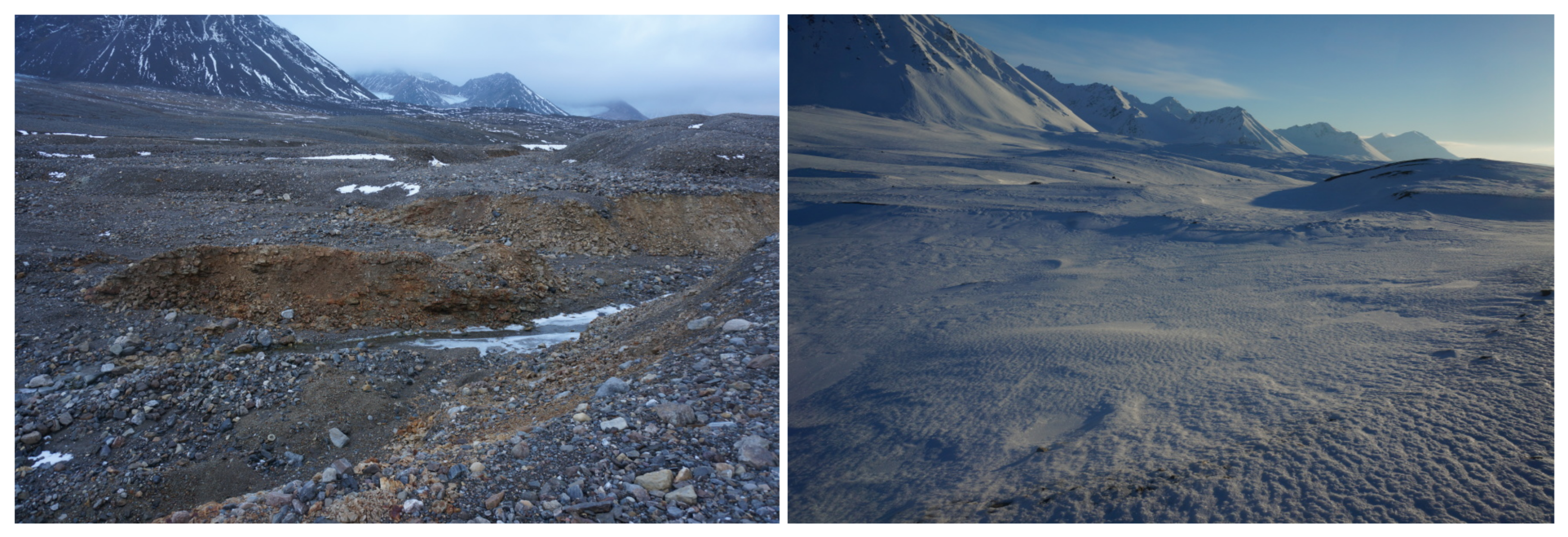
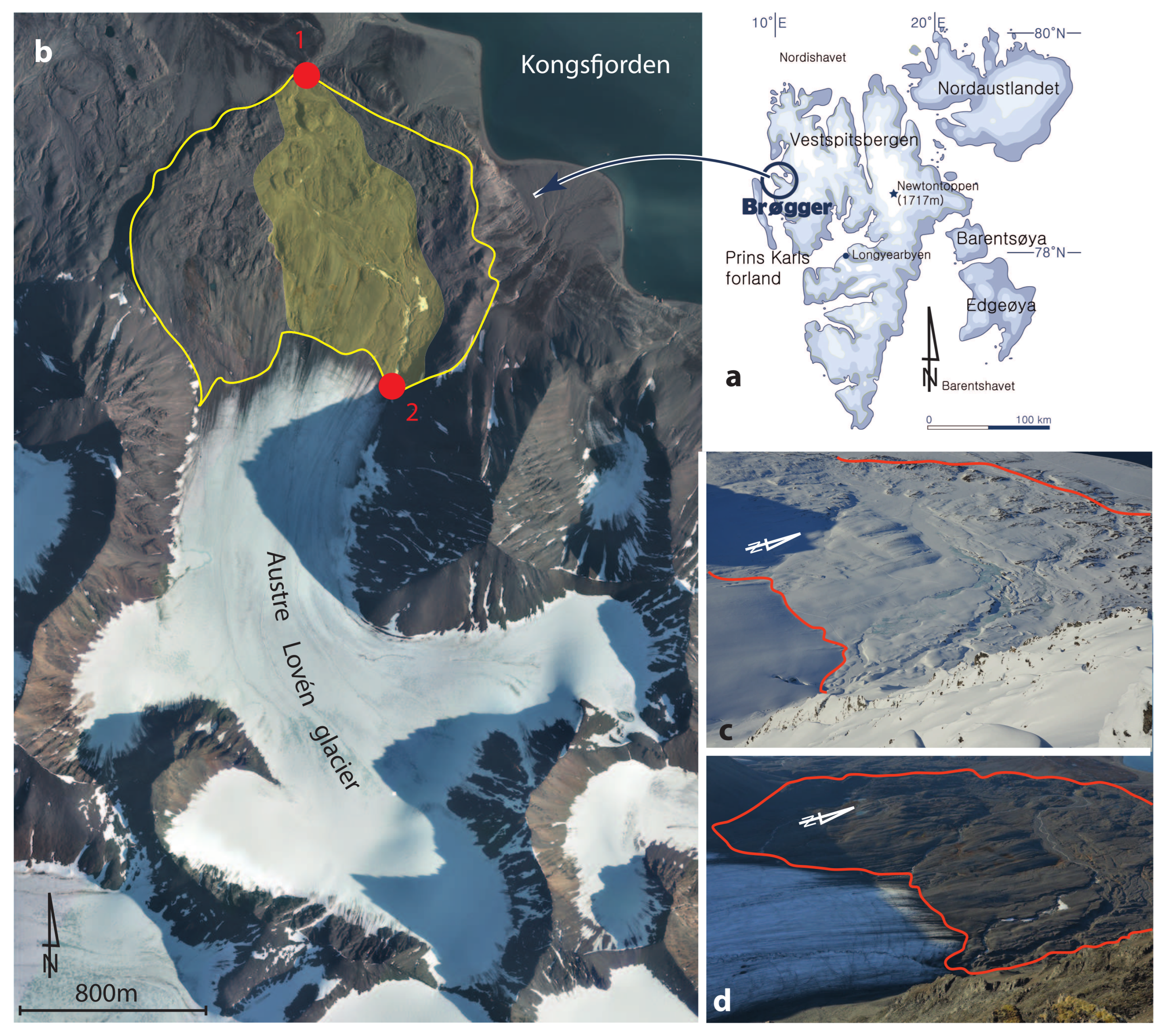
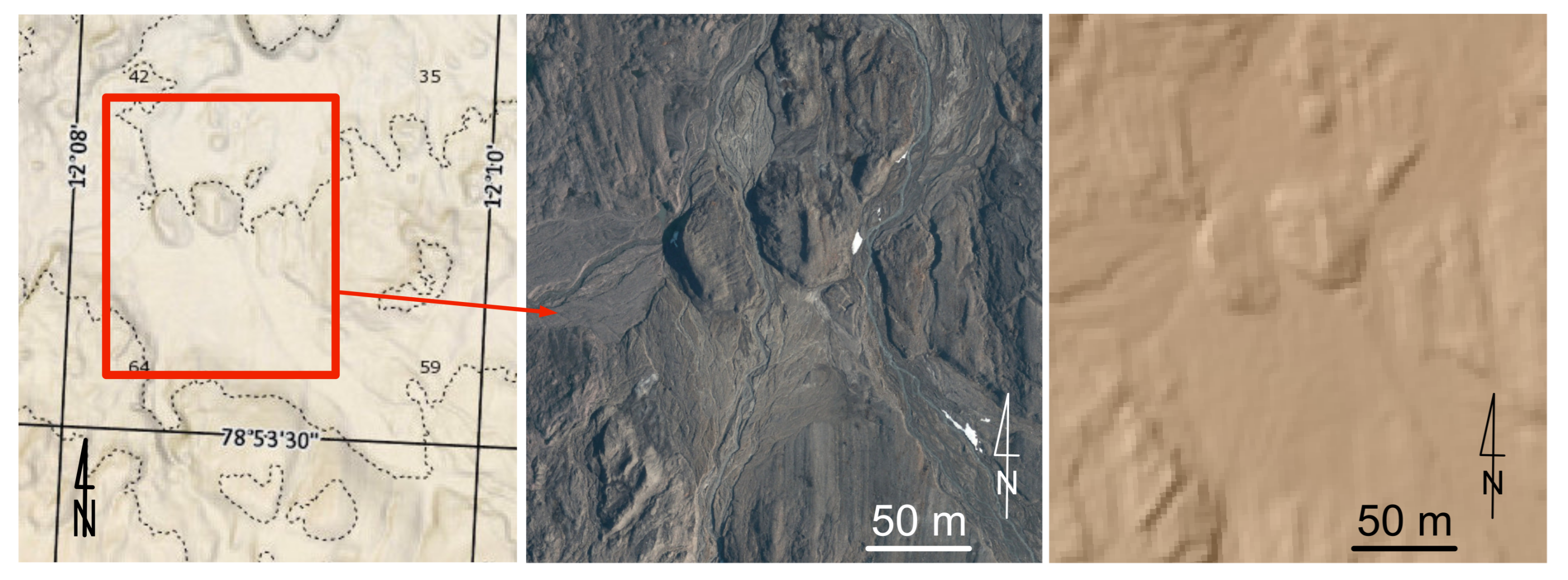
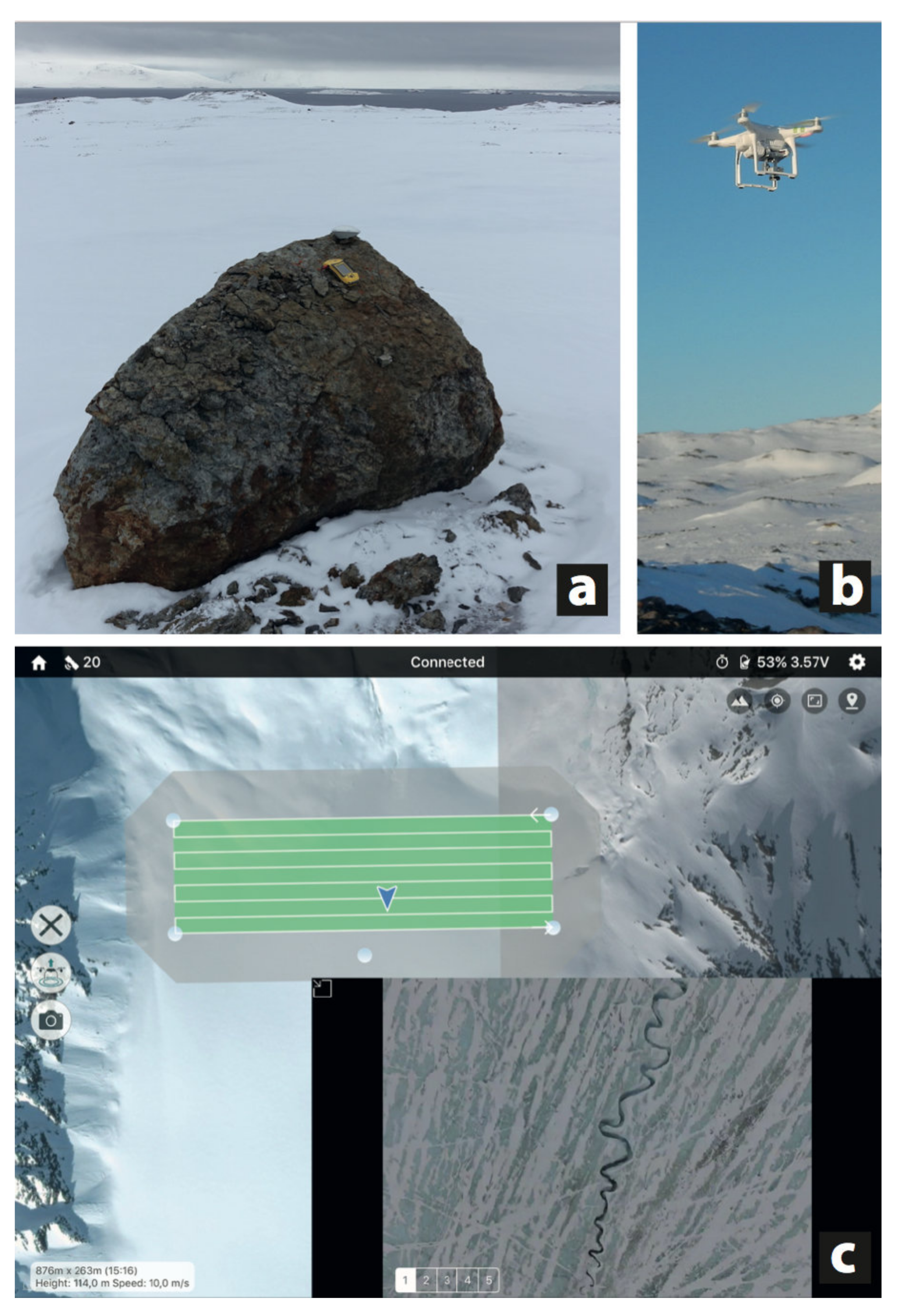



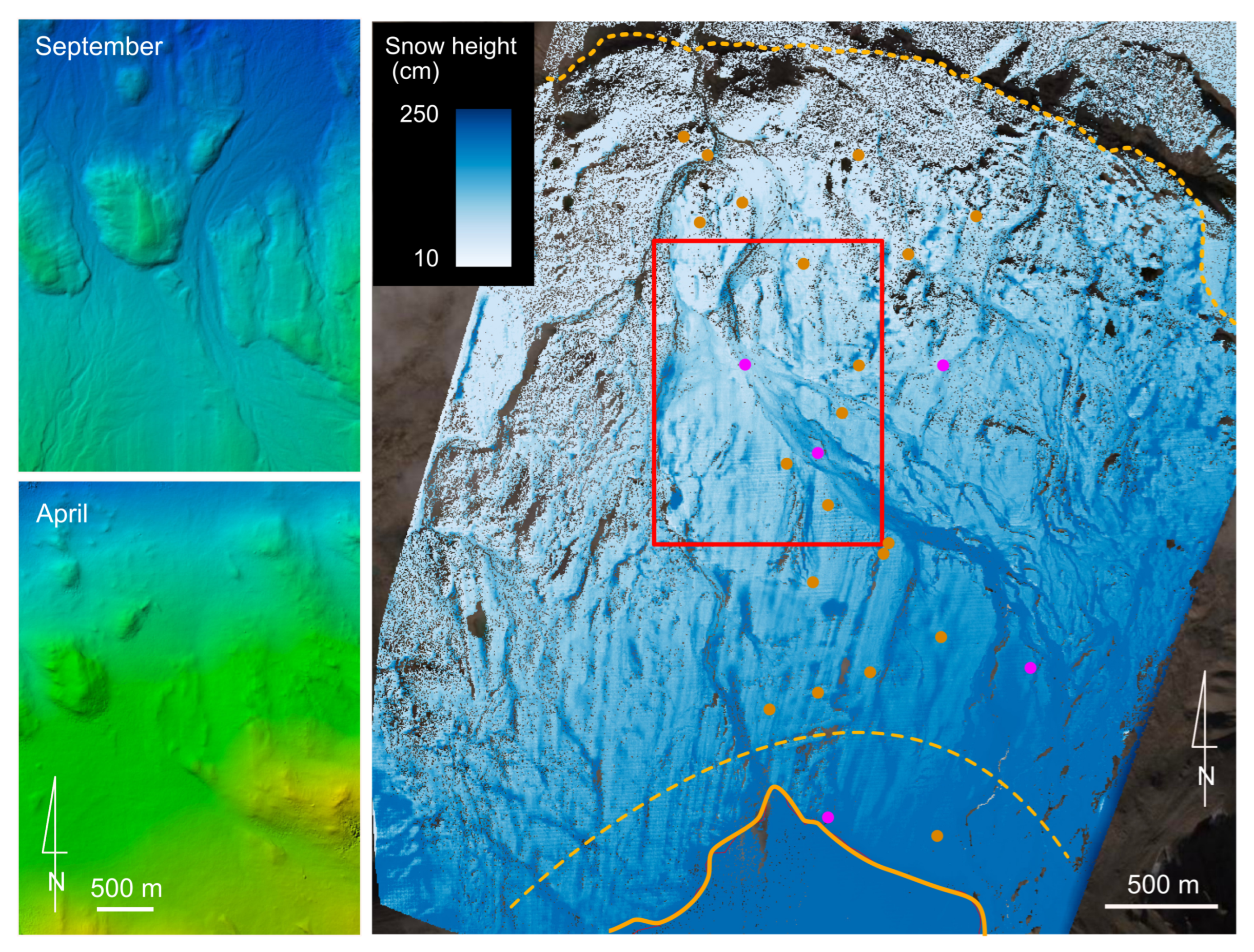
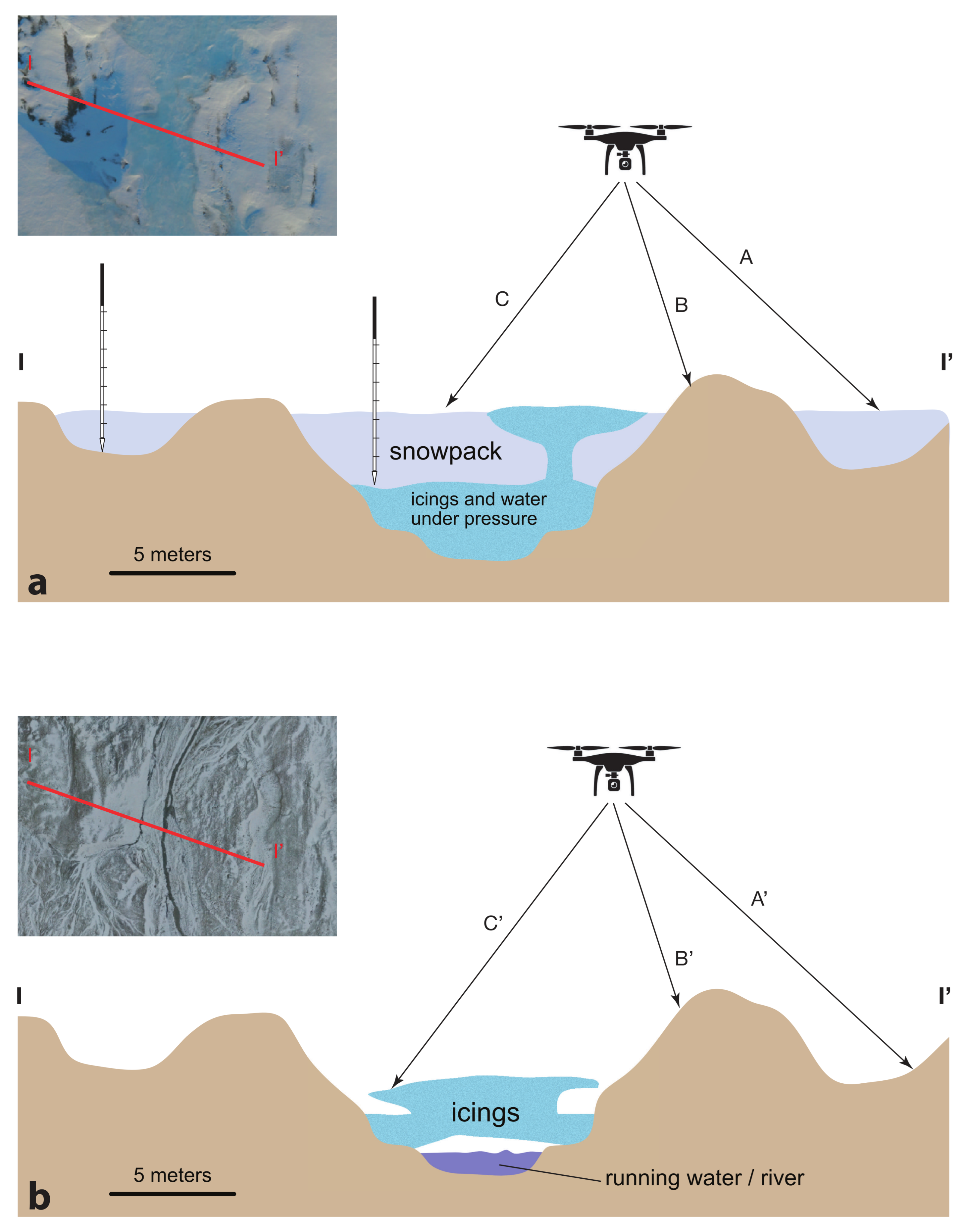
Publisher’s Note: MDPI stays neutral with regard to jurisdictional claims in published maps and institutional affiliations. |
© 2021 by the authors. Licensee MDPI, Basel, Switzerland. This article is an open access article distributed under the terms and conditions of the Creative Commons Attribution (CC BY) license (https://creativecommons.org/licenses/by/4.0/).
Share and Cite
Bernard, É.; Friedt, J.-M.; Griselin, M. Snowcover Survey over an Arctic Glacier Forefield: Contribution of Photogrammetry to Identify “Icing” Variability and Processes. Remote Sens. 2021, 13, 1978. https://doi.org/10.3390/rs13101978
Bernard É, Friedt J-M, Griselin M. Snowcover Survey over an Arctic Glacier Forefield: Contribution of Photogrammetry to Identify “Icing” Variability and Processes. Remote Sensing. 2021; 13(10):1978. https://doi.org/10.3390/rs13101978
Chicago/Turabian StyleBernard, Éric, Jean-Michel Friedt, and Madeleine Griselin. 2021. "Snowcover Survey over an Arctic Glacier Forefield: Contribution of Photogrammetry to Identify “Icing” Variability and Processes" Remote Sensing 13, no. 10: 1978. https://doi.org/10.3390/rs13101978
APA StyleBernard, É., Friedt, J.-M., & Griselin, M. (2021). Snowcover Survey over an Arctic Glacier Forefield: Contribution of Photogrammetry to Identify “Icing” Variability and Processes. Remote Sensing, 13(10), 1978. https://doi.org/10.3390/rs13101978





